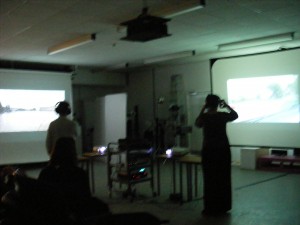Through the Bath Water
April -June 2012
Do you put your head under the bath water?
What can you hear under the bath water?
Do you remember putting their head under the bath water?

After a series of work called Through Walls, Through You – BEAM Festival – 2012, commissioned me to make a sound artwork called Through the Bath Water. The installation involved the public, listening to sounds over and under the bathwater.
.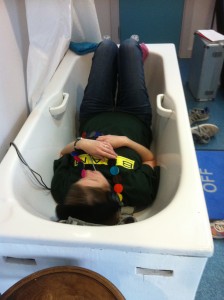
Listening to bathwater at BEAM Festival
It involved actively getting into an empty bath, and putting on headphones. Through the headphones listeners heard the sounds of the bath water running and on tilting their head back to a certain angle heard the sound of the water running but from under the water.
Try each headphone ear separately to compare sound
[audio:https://shirleypegna.com/wp-content/uploads/2012/08/bathwater.mp3|titles=bathwater]

Listening to bathwater at BEAM Festival
Sound artist Mike Blow put together an Arduino and Max Patch that ran in conjunction with the two sound files (of over and of under the water) such that when the head phones were tilted back the sensor on the Arduino got the Max Patch to play the other sound file. http://mikeblow.wordpress.com/

Headphones with tilt sensor sewn inside and Arduino
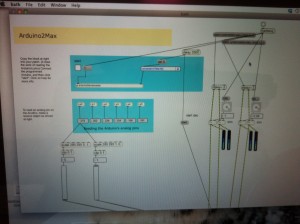
Max Patch
The contrasting sound of the change from over to under water reminded the listener of their own experience of: perhaps bathing as a child, plunging their heads under water to rinsing their hair of shampoo or just playing about.
You may wonder why any one would get in this bath, but the setting was inadvertently enticing: the bath was placed in a grey corridor near an outside door, with a bath mat requesting you politely to take off your shoes. I did wonder if the mat should say ’get in!’ but people did get in and by the expression on their faces they enjoyed the experience of the situation – shoes off and all!
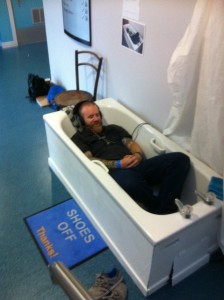
Listening to the bathwater at BEAM Festival
I was interested in connecting the listener with their own past experiences of hearing sound through differing materials, and the sounds being at different speeds connecting them to the underlying laws of physics that we all experience daily.
To do this I focused on one element: the sound. Rather than create or fabricate the whole bath experience and distract the listeners’ senses with:
• the vibration of the tap water running in, which could be done with transducers on the side of the bath,
• or the heat of the water on the skin – which also could be created,
I chose to concentrate on the sound to make the point of the comparison between the sound heard in air and water. I didn’t want to distract the audience from the sounds with other experiences.

Mics set to record in the bathroom
I set up mics in a bathroom, with a pair of AKG200 and a hydrophone recording simultaneously into the Edirol 44. I wanted to experiment and see what sound was like heard under water. I tried different things:
• putting the radio on,
• having people come in and say things,
• waiting till there was a racket out side the window,
• humming in the room loudly and then softly.
I found that as soon as there was some different element to follow other than the bath water, there became a narrative. This narrative, which was fun to conceive and create then over rode the focus on the sound itself and its behaviour, so I kept to the sound of the bath water.

Hydrophone in the bath
Sound travels faster through water than it does through air (Approximately 1482 mp/s in water as opposed to 344mp/s in air depending on the quality of both.
http://www.wolframalpha.com/input/?i=speed+of+sound+in+water).
The hydrophone under water sound, does not replicate the behaviour of our human ears listening under water. This brought up further questions about the way other mammals and fish ‘hear’ under water. I wondered if I needed to adjust the EQ on the recording to suggest it was listened to under water. I put a small amount of reverb on the over water sound to make a contrast with the under water sound.
Here was an interesting question –“ how much if any intervention could or should I consider making?’
Last year I was lucky enough to catch the tour Wet Sounds by Joel Cahen, where we listened under water to the sound tracks played under water. Have a look here: http://www.wetsounds.co.uk/ It brought up questions about how ears react under water to sound and how fish and marine mammals hear sound under water?
By making sure we could set up the max patch tilt for tilting forward and backward, this meant the listeners could put the head phones either way round.
There was positive feed back from the ‘bathers’, but a larger number of them requested that if next time if the bath could be bigger, it would be easier to slide down to hear the under water sounds.
• ‘Wet’
• ‘I do love a relaxing bath.’
• ‘It gives the experience of being a fish as you can still breathe under water.’
• ‘Taking my shoes off made me slow down…..’
• ‘Would a shower curtain change the experience?’
• ‘Great Thanks’
• ‘Thought I might feel naked in the bathe!’
• ‘Didn’t like staying in being watched.’
• ‘Would be interesting to hear voices and other sounds as well – live water?’
• ‘Refreshing – enjoyed this.’
• ‘How effected are the sounds? As sounds too loud in the phones make it seemed recorded.’
• ‘I actually cried when I heard the test version of this, as I can’t go under water with my ear problem.’
• ‘How relaxed are you? (is one?) Can you measure it?’
• ‘WANTED HEAT.’
• ‘Adjust the headphones so it doesn’t matter which way round you when you put on them on. The tilt goes both ways’.
• ‘Had some sense that there was the materiality of the water there.
• ‘I like the encapsulation – physically inside the bath and physically inside the phones. The environment was framed by the bath. It felt further closed up when listening to the under water sound. So re-meaning: isolated aural environment then further – so sound source an analogy.’
• ‘How about smoothing the change. Between the two sounds – merging them together.’
• ‘The bath’s a bit short to get the tilt back. When you are small- a child – baths are bigger and you usually put your head under.’
• ‘Made me laugh – much appreciated.’
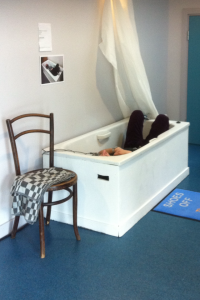
‘Under’ the bath water…
End
